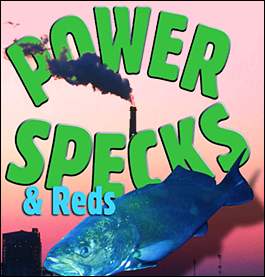|
 Power plant outfall canals consistently produce cold-weather redfish and trout action that's as hot as the water they release. Here's all you need to know to flip the switch and turn on the fun. Power plant outfall canals consistently produce cold-weather redfish and trout action that's as hot as the water they release. Here's all you need to know to flip the switch and turn on the fun.
By Chester Moore, Jr.
It looked way
too cold to go fishing. A thin blanket of ice carpeted the ground,
and small flurries of snow drifted down from the gray skies. Had
I been in Minnesota this would have been prime time for ice fishing,
but heading into such frigid conditions in Texas earns scrutinizing
stares from onlookers.
"Only
a crazy man would venture into such nasty weather. You guys need
straight jackets," the man at the boat launch told us.
My cousin Frank
Moore and I smiled and mumbled some little white lie like "It
ain't that bad." But it's safe to say we both agreed
with the man as we headed out into the 33-degree, stinging cold
morning. We would have worn straight jackets if they could've
kept us warmer.
The only "good"
thing about the weather was there was no wind to speak of. The
water in the Neches River was as smooth as glass, so the 16-foot
aluminum boat glided across it with great ease.
When we reached
our destination it seemed as if we were in some sort of strange,
twisted, winter dream. Icicles dangled from the high lines above
as steam rose from the water. At times it was so thick and rose
so high that we had to slow down to a virtual crawl to avoid a
collision with the bank or another boat. Being only half-awake,
I kept thinking this might be some sort of strange purgatory,
halfway between fishing heaven and hell.
Finally, I
snapped back into reality when Frank motioned for me to stop as
we came up to a big chain that blocked the canal. In the middle
of the chain was a sign that read: "No Trespassing; Property
of Entergy Corporation." We had reached the outflow station
of the Neches River Entergy Power Plant.
"We should
catch some fish," Frank said as he dipped his hand in the
water. "The water's really warm, so they must be pumping
out a lot today."
This Energy
Plant is like several similar outfits along the Texas Gulf Coast.
The plant cools its turbines by pumping water from one canal and
expelling it to another. In this case, the water comes from a
marsh that borders the Lower Neches Wildlife Management Area near
Bridge City and exits into a canal that leads to the mouth of
the Neches River-both of which usually hold salty water during
winter.
Baitfish congregate
in such warm water during cold spells, making them a sort of buffet
for a host of large predators like redfish and speckled trout.
They're great for human predators, too, since the cold-blooded
fish become much more active feeders in these spots than in the
much colder surrounding waters.
Frank and I
were the only anglers present in the canal that day, but there
were plenty of fish there. In fact, we limited on redfish and
black drum and caught more than a dozen speckled trout.
Not bad for
fishing in an ice storm.
Warm-water
discharges come in many forms. They can be huge cooling plants
that spew out thousands of gallons of warm water a minute or they
can be small drainage pipes or culverts that have a very light
flow. Oftentimes chemical refineries will have small pump stations
that producea warm-water flow that diverts into underwater pipes.
Any of these areas can hold a surprising amount of fish, but it's
safe to say that the more flow and the warmer the water in comparison
to the surrounding water, the more fish there will be.
Fish are often
concentrated in such great numbers in these canals that they become
easy pickings. Galveston-area guide Capt. George Knighten says
that before limits were in place he remembers catching several
ice chests of speckled trout at a time at the HL&P (Houston
Lighting & Power Co.) outfall in Trinity Bay.
continued
page 1 / page 2
| 




